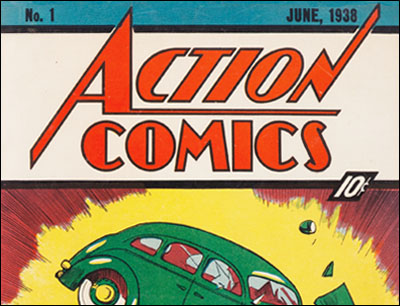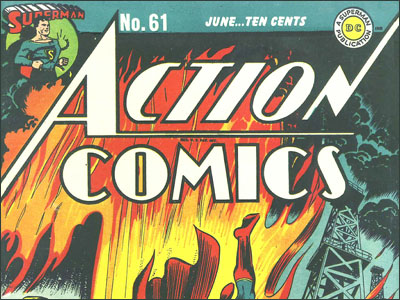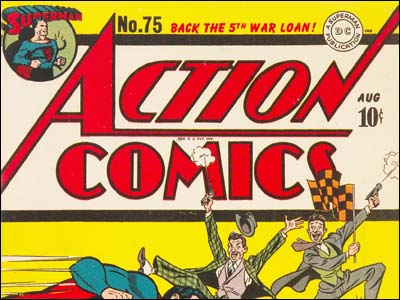With rare exceptions, comic books are printed on presses that handle "signatures" of eight pages — so the insides of a comic book usually must be a multiple of eight pages. The way some printers' presses worked, they had to be multiples of sixteen pages.
These days, those "insides" are on pretty good paper stock but for its first four or so decades, the industry put those insides on the cheapest paper available. Then they'd print a four page signature on a different, more expensive press with more expensive paper and that would form the cover, the inside front cover, the inside back cover and the back cover.
Bind it all together and you had yourself a comic book.

As an example, let's take a long-running book like Action Comics. Action Comics #1 came out on May 3, 1938 and it featured the debut of some obscure character named Superman. The issue contained…
- Superman (pg. 1–13) by Jerry Siegel and Joe Shuster
- Chuck Dawson (pgs. 14–19) by H. Fleming
- Zatara, Master Magician (pgs. 20–31) by Fred Guardineer
- "South Sea Strategy" (text feature, pgs. 32–33) by Captain Frank Thomas
- Sticky-Mitt Stimson (pgs. 34–37) by Alger
- The Adventures of Marco Polo (pgs. 38–41) by Sven Elven
- Pep Morgan (pgs. 42–45) by Fred Guardineer
- Scoop Scanlon (pgs. 46–51) by Will Ely
- Tex Thomson (pgs. 52–63) by Bernard Baily
- Stardust (pg. 64) by "The Star-Gazer"
There was also a front cover, an inside front cover telling us about the comic, an inside back cover ("Odds 'N Ends" by Sheldon Moldoff) and an ad on the back cover. For the purposes of this article, we shall henceforth ignore covers and all page counts will be referring to the interiors. So Action Comics #1 had 64 pages…and it cost a dime.
That was how big an issue of Action Comics was for a while but as we know, prices go up. They go up on printing and they also go up on what writers and artists have to spend each week on food and rent…so what they were paid had to go up. Furthermore, as World War II wound down, paper costs soared and it became apparent to all funnybook publishers that they either had to raise prices or decrease page count. As far as I know, there was no consultation among the many houses that put out comics. They all just kind of decided that "kids" (which is how they referred to their customers) would object to paying more and it was preferable to give them less.

So as of #61, which came out in April of 1943, Action Comics lost eight pages, slimming down to 56 pages. That size didn't last long. It was more efficient to print 16-page signatures so a little more than a year after going from 64 to 56, Action Comics (and most others) went to 48 pages. Action Comics #75 was the first Action Comics of this thickness.

A few publishers had longer-term contracts with their printers or other arrangements that kept costs down but the whole industry pretty much moved to 48 pages…

…until 1951 when another downsizing of the package seemed necessary. Action Comics #162, which came out in September of that year, was 40 pages.
And then in 1954, DC faced a moment of truth. They either had to go to 32 pages or raise the cover price from ten cents.
Other companies had already made that decision. Martin Goodman's company — the firm we now know as Marvel — had been offering 32 pages for a dime for over a year. Fawcett — the output publishing Captain Marvel (the one in the red suit who said "Shazam!" a lot) had been selling 32 pages for ten cents since about the time DC went to 40 pages. Other companies bounced around. Dell for quite some time put out some 32-page comics for ten cents and some 48 page ones for the same price.
But in '54, DC had to decide what to do. 32 pages for ten cents or raise the cover price? I once asked Whitney Ellsworth, who had the title of Editor-in-Chief at DC then and he muttered something I didn't quite understand. Mr. Ellsworth was one of the most nervous, terrified-of-saying-the-wrong-thing human beings I have ever encountered and I think (italicized for emphasis) that what he said was something like, "We looked at the sales of other companies and it didn't seem like going to 32 pages had hurt sales."
And I'm pretty sure he said — and this is a paraphrase but it's close — "We knew that if we raised the price and anyone else stayed at a dime, we'd get murdered." So DC went to 32 pages for ten cents and pretty soon, that became the standard for any comic book that wasn't so thick that it felt like a special. The first 32 page issue of Action Comics was #197 which hit the newsstands in August of 1954.

You really couldn't make a comic book any thinner than that…so the next time costs went up for the publishers, they were going to have to do something they dreaded, something they feared greatly. They were going to have to raise the price.
I'll continue this in Part 2 in a few days.